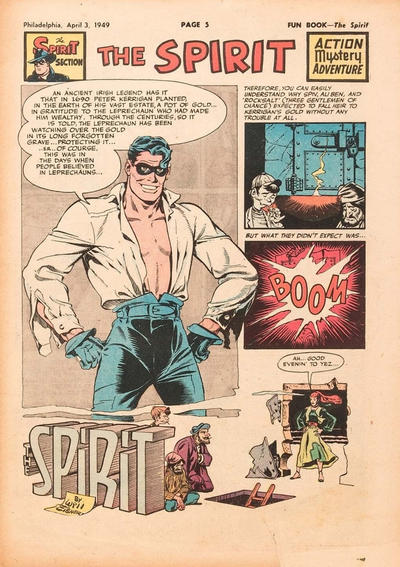Will Eisner is the most important figure in the history of comic books. That's a bold claim, but let me explain. Eisner was one of the earliest creators of new content for the burgeoning field of comic books, the weaker sister of the noble comic strip. After a brief tenure in comic strips, he and Jerry Iger formed a partnership to supply comic material for the sundry publishers who rose up after the hit Superman made a new industry viable. Leading other great talents he helped contribute to comics such as Sheena of the Jungle, The Flame, Doll Man, and Blackhawk among others. Eventually he left to set up his own shop called logically enough Eisner Studio and out of that came The Spirit. The Spirit was a comic book produced for inclusion in newspapers which had seen the potential for such things to raise circulation. The singular thing about the Spirit is that Eisner maintained his rights over the character which proved critical over the next many decades. The comic was hugely successful and ran for a until the early 50's during which time Eisner had created a range of different kinds of stories which deviated greatly from mere crime yarns.
Will Eisner proved comic books could be more than just disposable junk. He then when to work for the military where he used comics to teach soldiers about their equipment in P.S. Magazine, and left his most famous creation behind, but people remembered. There were revivals in the 60's and 70's and beyond. Eisner began to create longer form stories which were grounded in stark reality and later still adapted novels and fairy tales. He wrote at least two books about creating comics. Eventually DC acquired the rights and hold them today. Will Eisner was there at the beginning, the revival, and was a major influence on many creators both in the mainstream and underground. His stories are exceedingly well crafted and touch on themes which still resonate today. No single talent was as good as long as Will Eisner. Even so a mighty talent as Jack Kirby bends the knee to Eisner who combined great storytelling and longevity with a sharp business acumen that made for a successful working model for comics.
IDW's Artisan Edition of The Spirit stories is wonderful way to get an intimate look at Eisner's work on his greatest and most enduring creation when he was at the peak of his artistic powers. Below are the splash pages of the particular "Spirit Sections" which are included in this tome in order, though of course they are in glorious black and tan. It's an economical version of the Artist's Editon produced some years ago and much more readable.
Rip Off



.jpg)

























My introduction to The Spirit was with the Harvey comics in '66 and '67. I had read my fair share of comics by then, but these were something entirely different. Even back then I recognized that Eisner was something special and he came from an entirely different place from Kirby, Infantino, et al. The first issue's "The Story of Rat-Tat the Toy Machine Gun", "Ten Minutes" and the ironic "Gerhard Shnobble" were stories with a message and way ahead of their time. Eisner rightfully sits with just a few others on top of the heap.
ReplyDeleteI first encountered the Spirit in the pages of Feiffer's The Great Comic Book Heroes and that story is an early one and while quite nice doesn't showcase the greatness of the strip to best effect. It wasn't until Warren's reprints that I got plugged in.
DeleteMy first encounter with The Spirit was via a single illustration of him (and other characters like Buck Rogers, The Phantom etc) in adverts that appeared in DC comic for the Menomomee Falls Gazette around the mid 1970s. O only realised that the illustration was of The Sport as I knew all The other characters.The first comic I read would have been in the early 1980s when I picked up an old Warren Spirit mag from 1974 (issue 3 "Black Alley") it was so fresh with amazing art and a great story. I have managed to track down most of the Spirit Warren mags since then and have the reprint of Eisner's PS Magazine which has some great art.
ReplyDeleteA strange thing about my Eisner learning curve was that I actually encountered the lush artwork of Mike Ploog on Werewolf by Night and Ghost Rider before I found the original source in the pages of Warren's The Spirit. Ploog had been Eisner's assistant, so I was impressed by the acolyte before I met the master.
Delete